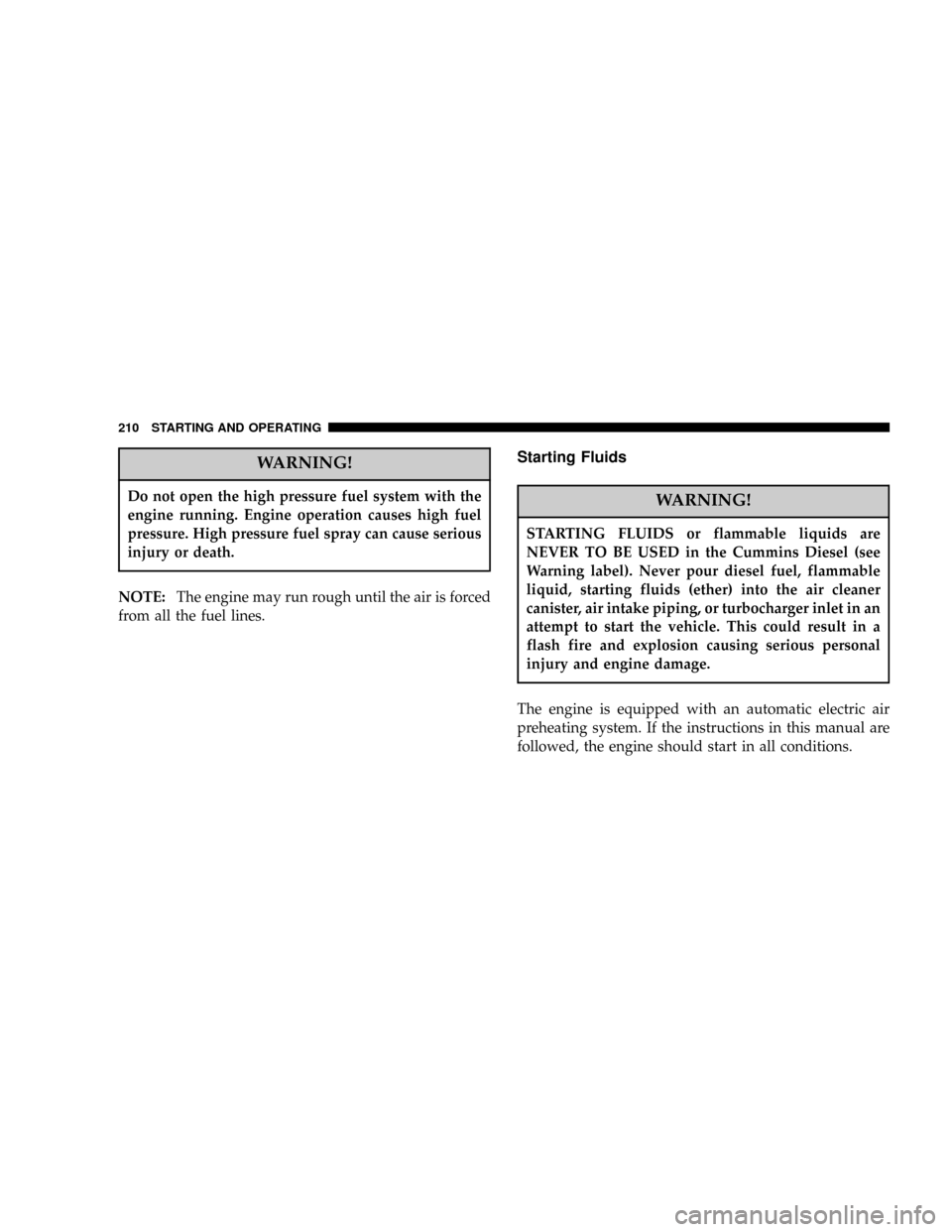DODGE RAM 2500 DIESEL 2004 3.G Owners Manual
Manufacturer: DODGE, Model Year: 2004, Model line: RAM 2500 DIESEL, Model: DODGE RAM 2500 DIESEL 2004 3.GPages: 426, PDF Size: 7.22 MB
Page 201 of 426

NTire Loading And Tire Pressure...........247
mTiresÐGeneral Information................251
NTire Pressure.........................251
NTire Inflation Pressures.................252
NRadial-Ply Tires......................255
NCompact Spare Tire Ð If Equipped.........255
NTire Spinning........................256
NTread Wear Indicators..................257
NReplacement Tires.....................257
NAlignment And Balance.................258
mSupplemental Tire Pressure Information.......259
mTire Chains...........................259
mSnow Tires...........................261mTire Rotation Recommendations............261
NDual Rear Wheels.....................263
mEngine Runaway.......................264
mFuel Requirements......................264
NAdding Fuel.........................265
NBulk Fuel Storage.....................267
NFuel Specifications....................267
mVehicle Loading........................269
NCertification Label.....................269
mTrailer Towing.........................272
NTo Maintain Warranty Coverage...........272
NAxle Lubricant And Trailer Towing.........274
NTrailer Towing Recommendations..........274
STARTING AND OPERATING 201
5
Page 202 of 426

NTrailer Towing Ð Hitches...............275
NConnecting Trailer Lighting And Electric
Trailer Brakes........................276
NTrailer Weight And Trailer Tongue Weight....278
NTrailer Towing Information
(Maximum Trailer Weight Ratings).........279
NTrailer Towing Mirrors Ð If Equipped......279
NCooling System Tips Ð Trailer Towing......280
NAutomatic Transmission Oil Temperature
Warning Light.......................281
NTowing With An Automatic Transmission....281
mSnowplow............................282
NBefore Plowing.......................283
NSnowplow Prep Package Model Availability . . 283NOver The Road Operation With Snowplow
Attached...........................284
NMethods For Removing Snow............284
NOperating Tips.......................284
NGeneral Maintenance...................285
mRecreational Towing Ð 4±Wheel Drive Vehicles
(Behind Motorhome, Etc.).................286
NRecreational Towing Procedure Ð Manual
Shift Transfer Case Ð If Equipped.........286
NReturning To Normal Operation Ð Manual
Shift Transfer Case....................287
NRecreational Towing Procedure Ð Electronic
Shift Transfer Case Ð If Equipped.........288
NReturning To Normal Operation Ð Electronic
Shift Transfer Case....................290
202 STARTING AND OPERATING
Page 203 of 426

mDriving Off-Road.......................292
mTraction.............................293mEngine Data Plate......................294
STARTING AND OPERATING 203
5
Page 204 of 426

IGNITION/STARTER SWITCH
LOCK
Locks the automatic transmission shift control into the
PARK position. It also engages the steering wheel lock (if
equipped) when the steering wheel is turned.NOTE: This vehicle is equipped with a transmission
shift interlocking system. The brake pedal must be
depressed to shift out of Park (P).
OFF
Unlocks the steering wheel (if equipped with locking
wheel) and the automatic transmission shift control with
engine off.
ON
This is the normal running position.
START
Starts the engine. When the engine starts, release the key.
The ignition key will return to the ON position for
normal driving.
204 STARTING AND OPERATING
Page 205 of 426

ACC
Allows the electrical accessories to be used when the
engine is not running.
Manual Transmission Key Release Button
To remove the key on vehicles equipped with manual
transmissions, turn the key to the Lock position and press
the button to remove the ignition key.
Key Reminder
An alarm will sound to remind you if the key is left in the
ignition and the driver's door is opened.
STARTING PROCEDURES
The Cummins Diesel engine is equipped with several
features designed to assist cold weather starting and
operation:
²The engine block heater is a resistance heater installed
in the water jacket of the engine just above and behind
the oil filter. It requires a 110±115 volt AC electrical
outlet with a grounded, three-wire extension cord.
NOTE:The engine block heater cord is a factory in-
stalled option. If your vehicle is not equipped, heater
cords are available from your authorized Mopartdealer.
²A 12±volt heater built into the fuel filter housing aids
in preventing fuel gelling. It is controlled by a built-in
thermostat.
STARTING AND OPERATING 205
5
Page 206 of 426

²A heated intake air system both improves engine
starting and reduces the amount of white smoke
generated by a warming engine.
Normal Starting Procedure Ð Engine Manifold
AirTemperature Above 66ÉF (19ÉC)
Observe the Instrument Panel Cluster lights when start-
ing the engine.
1. Always apply the parking brake.
2. Shift into PARK for an automatic transmission. Fully
depress and hold the clutch and shift into NEUTRAL for
a manual transmission. Models with manual transmis-
sion are equipped with a clutch interlocking cranking
system. The clutch must be fully depressed to start the
vehicle.
3. Turn the ignition key to the ON position and look at
the instrument panel cluster lamps.The lamps in the instrument panel cluster will illuminate
when the ignition key is first turned to the ON position.
This is a bulb check programmed to last for approxi-
mately 3 seconds. After the bulb check is completed, the
Malfunction Indicator Light and Brake Warning light will
remain on. After the bulb check is complete and the
WAIT TO START indicator goes out proceed to step 4.
CAUTION!
If WATER IN FUEL indicator light remains on DO
NOT START engine before you drain water from the
fuel filter to avoid engine damage. See Section 7 Ð
Maintaining Your Vehicle, for water drain proce-
dures.
4. Turn the ignition key to START and crank the engine.
Do not press the accelerator during starting.
206 STARTING AND OPERATING
Page 207 of 426

CAUTION!
Do not crank engine for more than 15 seconds at a
time as starter motor damage may result. Turn key to
OFF and wait at least two minutes before trying
again.
5. When the engine starts, release the key.
6. Check to see that there is oil pressure.
7. Release the parking brake.
Starting Procedure Ð Engine Manifold Air
Temperature Below 66ÉF (19ÉC)
NOTE:The temperature displayed on the overhead
console (if equipped) does not necessarily reflect the
engine manifold air temperature. The wait-to-start lamp
will illuminate momentarily for a bulb check when the
ignition key is turned to the ON position, however whencertain engine temperatures fall below 66ÉF (19ÉC) the
lamp will remain on indicating the intake manifold
heater system is active.
Follow the steps in the Normal Starting Procedure ex-
cept:
CAUTION!
Do not crank engine for more than 15 seconds at a
time or starter motor damage may result. Turn key to
OFF and wait at least 2 minutes for starter to cool
before repeating start procedure.
²The WAIT TO START light will remain on for a period
of time (length of time depends on engine tempera-
ture) after completion of the bulb check.
STARTING AND OPERATING 207
5
Page 208 of 426

²After the WAIT TO START light goes off, turn the
ignition key to START. Do not press the accelerator
during starting.
²Check to see that there is oil pressure.
²Allow the engine to idle at fast idle for about three
minutes until the manifold heaters have completed
the post-heat cycle.
²Release the parking brake and drive.
NOTE:Engine idle speed will automatically increase to
1000 rpm at low coolant temperatures to improve engine
warm-up.
NOTE:If the engine stalls or if the ignition switch is left
On for more than 2 minutes after the WAIT TO START
light goes out, reset the grid heaters by turning the
ignition switch to Off and the back On. Repeat steps 3
through 7 of the normal starting procedure.
For Extremely Cold Weather Starting (Engine
Temperature Below 0ÉF (- 18ÉC)
In extremely cold weather below 0ÉF (- 18ÉC) it may be
beneficial to cycle the manifold heaters twice before
attempting to start the engine. This can be accomplished
by turning the ignition OFF and then back ON after the
WAIT TO START light has gone off, but before the engine
is started. However, repeated cycling of the manifold
heaters will result in damage to the heater elements or
reduced battery voltage.
NOTE: If multiple pre-heat cycles are used before
starting, additional engine run time may be required to
maintain battery state of charge at a satisfactory level.
²If the engine stalls after the initial start, the ignition
must be turned to the OFF position and then to the ON
position to recycle the manifold heaters.
NOTE:Excessive white smoke and poor engine perfor-
mance will result if manifold heaters are not recycled.
208 STARTING AND OPERATING
Page 209 of 426

²Heat generated by the manifold heaters dissipates
rapidly in a cold engine. If more than two minutes
pass between the time the WAIT TO START light goes
OFF and the engine is started, recycle the manifold
heaters by turning the ignition OFF and then back ON.
²If the vehicle is driven and vehicle speed exceeds 18
mph (29 km) before the manifold heater post-heat
(after start) cycle is complete, the manifold heaters will
shut off.
²If the engine is started before the WAIT TO START
light turns off, the preheat cycle will turn off.
²If the engine is cranked for more than 10 seconds, the
post-heat cycle will turn off.
NOTE:Engine idle speed will automatically increase to
1000 rpm at low coolant temperatures to improve engine
warm-up.NOTE:When a diesel engine is allowed to run out of
fuel or the fuel gels at low temperatures, air is pulled into
the fuel system.
You may try priming as described below.
1. Add a substantial quantity of fuel to the tank (5 to 10
gallons) or eliminate the gelled fuel condition.
2. Crank the engine for 1 to 2 seconds. If the engine does
not start, then release the key or starter button back to the
RUN position (do not turn the key back to the OFF
position). The electric fuel transfer pump will continue to
run and purge air from the system for about 25 seconds.
After 25 seconds, attempt to start the engine again.
3. Start the engine using the Normal Starting Procedure.
4. Repeat the procedure if the engine does not start.
STARTING AND OPERATING 209
5
Page 210 of 426

WARNING!
Do not open the high pressure fuel system with the
engine running. Engine operation causes high fuel
pressure. High pressure fuel spray can cause serious
injury or death.
NOTE:The engine may run rough until the air is forced
from all the fuel lines.
Starting Fluids
WARNING!
STARTING FLUIDS or flammable liquids are
NEVER TO BE USED in the Cummins Diesel (see
Warning label). Never pour diesel fuel, flammable
liquid, starting fluids (ether) into the air cleaner
canister, air intake piping, or turbocharger inlet in an
attempt to start the vehicle. This could result in a
flash fire and explosion causing serious personal
injury and engine damage.
The engine is equipped with an automatic electric air
preheating system. If the instructions in this manual are
followed, the engine should start in all conditions.
210 STARTING AND OPERATING